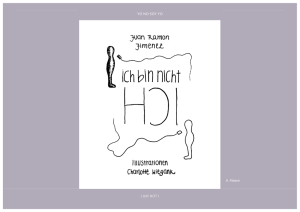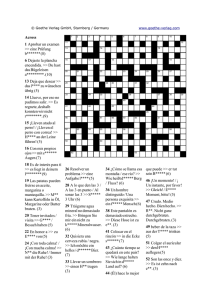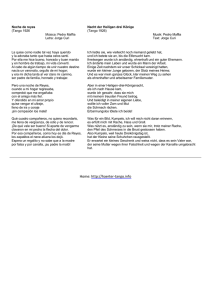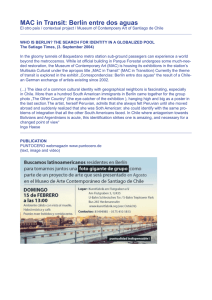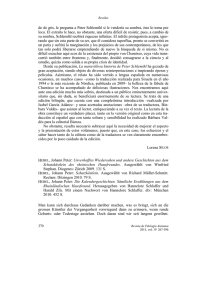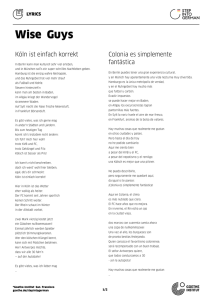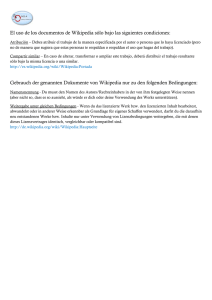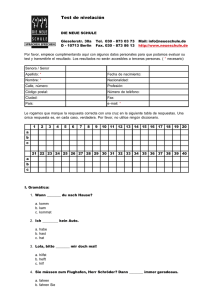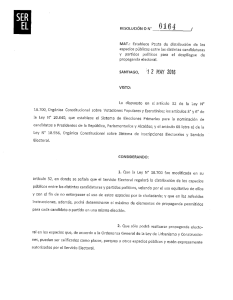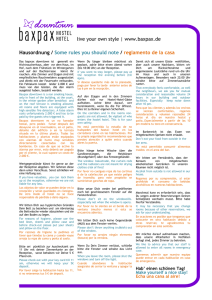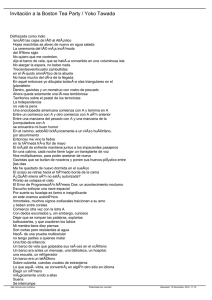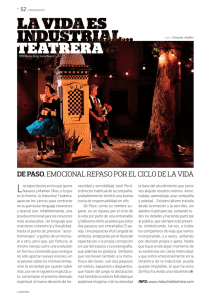Statement English
Anuncio
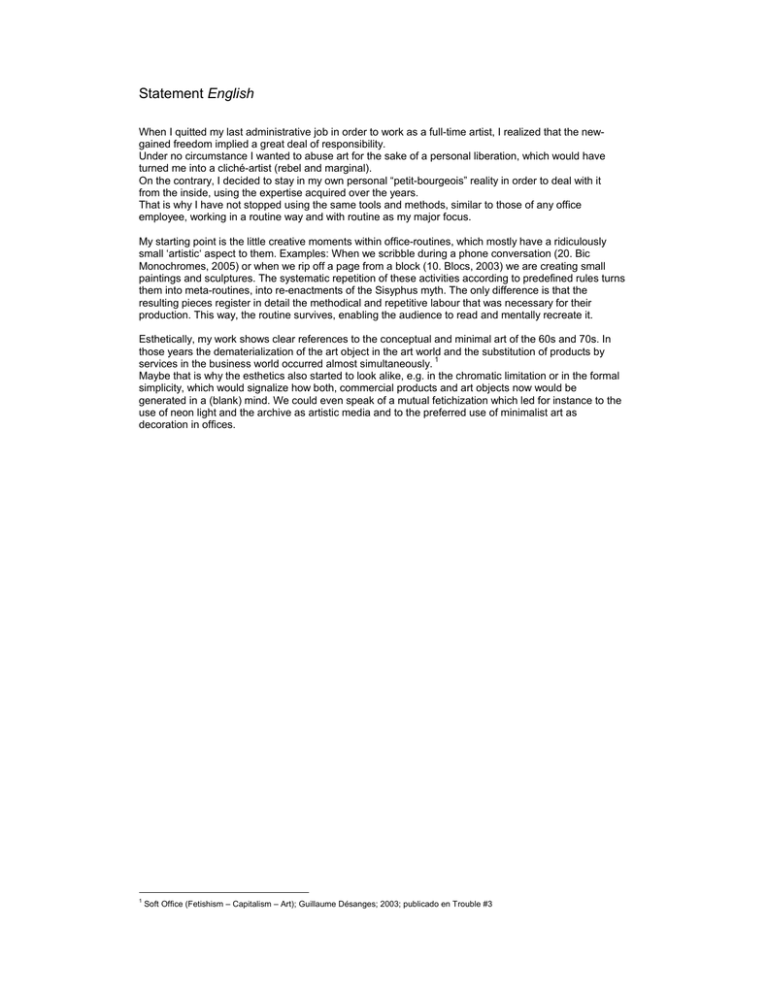
Statement English When I quitted my last administrative job in order to work as a full-time artist, I realized that the newgained freedom implied a great deal of responsibility. Under no circumstance I wanted to abuse art for the sake of a personal liberation, which would have turned me into a cliché-artist (rebel and marginal). On the contrary, I decided to stay in my own personal “petit-bourgeois” reality in order to deal with it from the inside, using the expertise acquired over the years. That is why I have not stopped using the same tools and methods, similar to those of any office employee, working in a routine way and with routine as my major focus. My starting point is the little creative moments within office-routines, which mostly have a ridiculously small ‘artistic‘ aspect to them. Examples: When we scribble during a phone conversation (20. Bic Monochromes, 2005) or when we rip off a page from a block (10. Blocs, 2003) we are creating small paintings and sculptures. The systematic repetition of these activities according to predefined rules turns them into meta-routines, into re-enactments of the Sisyphus myth. The only difference is that the resulting pieces register in detail the methodical and repetitive labour that was necessary for their production. This way, the routine survives, enabling the audience to read and mentally recreate it. Esthetically, my work shows clear references to the conceptual and minimal art of the 60s and 70s. In those years the dematerialization of the art object in the art world and the substitution of products by services in the business world occurred almost simultaneously. 1 Maybe that is why the esthetics also started to look alike, e.g. in the chromatic limitation or in the formal simplicity, which would signalize how both, commercial products and art objects now would be generated in a (blank) mind. We could even speak of a mutual fetichization which led for instance to the use of neon light and the archive as artistic media and to the preferred use of minimalist art as decoration in offices. 1 Soft Office (Fetishism – Capitalism – Art); Guillaume Désanges; 2003; publicado en Trouble #3 Statement español Cuando dejé mi vida de empleado administrativo para dedicarme de lleno al arte, me di cuenta de que la libertad adquirida implicaba una gran responsabilidad. De ninguna manera quería abusar del arte para lograr una liberación personal que me asimilase al artista cliché, rebelde y marginal, si no que al contrario, quería permanecer en mi propia realidad pequeñoburguesa para tratarla desde adentro con conocimiento de causa. Por eso, no he dejado de utilizar herramientas y métodos similares a los de cualquier empleado administrativo, trabajando siempre de manera rutinaria y con la rutina como foco temático. A nivel estético, mi trabajo tiene claras referencias al arte conceptual y minimalista de los años 60. Fue entonces cuando se dio de manera casi simultánea la ‘desmaterialización del objeto artístico’ en el 2 mundo del arte y la sustitución de productos por servicios en el mundo de la empresa. Quizá por ello, las estéticas también empezaron a asimilarse, por ejemplo en la limitación cromática a y en la simplicidad formal, que señalizarían como tanto el producto comercial como el objeto artístico ahora se generarían en la mente (en blanco). Se podría hablar incluso de una fetichización mutua, que llevó por ejemplo al uso de la luz de neon y el archivero como medios artísticos y al uso de arte minimalista como decoración preferida en oficinas. Los trabajos documentados en esta página web siguen con la misma línea de trabajo y estética. Parten de situaciones ó momentos en las rutinas de oficina, que muchas veces tienen algún aspecto ‘artístico’, casi siempre ridículamente pequeño. Ejemplos: Cuando pintamos garabatos durante una conversación telefónica (20. Bic Monochromes) ó cuando doblamos una hoja antes de meterla en un sobre (03. A line up and down an A4-sheet) estamos realizando pequeños actos pictóricos y escultóricos. La repeticicón sistemática de estas actividades según reglas predefinidas, las convierte en meta-rutinas, en reescinificaciones del mito de Sísifo. La única diferencia quizá sea que las obras resultantes registran en detalle el esfuerzo metódico y repetitivo que llevó a su producción. Así, la rutina sobrevive; se hace legible y recreable para cualquier expectador. 2 Soft Office (Fetishism – Capitalism – Art); Guillaume Désanges; 2003; publicado en Trouble #3 Statement Deutsch Nach Kündigung meiner letzten Büroarbeit und dem Entschluss, mich hauptberuflich mit Kunst zu befassen, stellte ich fest, dass die neu errungene Freiheit eine grosse Verantwortung birgte. Auf keinen Fall wollte ich Kunst dazu missbrauchen, eine persönliche Befreiung zu bewirken, die mich dem reaktionären und marginalen Klische-Künstler angleichen würde. Ganz im Gegenteil: Ich beschloss, meine eigene kleinbürgerliche Realität auf keinen Fall zu verlassen, um sie von innen heraus und mit der nötigen Fachkenntnis behandeln zu können. Deswegen verwende ich, auch als Künstler, die üblichen Werkzeuge und Methoden eines Büroangestellten und arbeite stets routiniert und mit der Routine als Hautpbeschäftigungsfeld. Ästhetisch lehnt sich meine Arbeit an die Konzept- und Minimal-Kunst der 60er Jahre an. In den 60ern fand fast zeitgleich zur ‘Dematerialisierung des Kunstobjektes’ die Substitution von Produkten durch Dienstleistungen in der Wirtschaft statt.3 Daraus ergab sich, dass sich Kunst- und Wirtschaftswelt auch ästhetisch immer näher kamen, beispielsweise in der chromatischen Selbstbeschränkung und in der formalen Simplizität, welche signalisieren sollten, wie Produkt und Kunstobjekt fortan im (leeren) Kopf generiert würden. Man könnte sogar von einer gegenseitigen Fetischisierung sprechen, welche sich beispielsweise darin äusserte, dass nun Neonlicht und Archivregal als Kunstmedium eingesetzt wurden oder aber Minimalkunst als Raumdekoration in Büros bevorzugt wurde. Die auf dieser Web-site enthaltenen Arbeiten führen die gleiche Arbeitslinie und Ästhetik fort. Ich gehe von Momenten im Büro-Alltag aus, welche oft einen ‘artistischen’ Aspekt aufweisen, der fast immer lächerlich klein ist. Beispiele: Wenn wir während eines Telefongesprächs kritzeln (20. Bic Monochromes) oder wenn wir ein Blatt falten bevor wir es in einen Briefumschlag stecken (03. a line up and down an A4-sheet) realisieren wir, ganz unbewusst und routiniert, kleine malerische und skulpturale Aktionen. Die systematische Wiederholung dieser Aktionen nach vorab bestimmten Regeln, verwandelt sie in Meta-Routinen, in Reinszenierungen des Sisyphus-Mythos. Der einzige Unterschied liegt vielleicht darin, dass die methodische und repetitive Arbeit, die zur Herstellung der Werke notwendig ist, hier en detail registriert wird. Auf diese Weise überlebt die Routine und macht sich für jeden Zuschauer lesbar und nachvollziehbar. 3 Soft Office (Fetishism – Capitalism – Art); Guillaume Désanges; 2003; erschienen in Trouble #3
